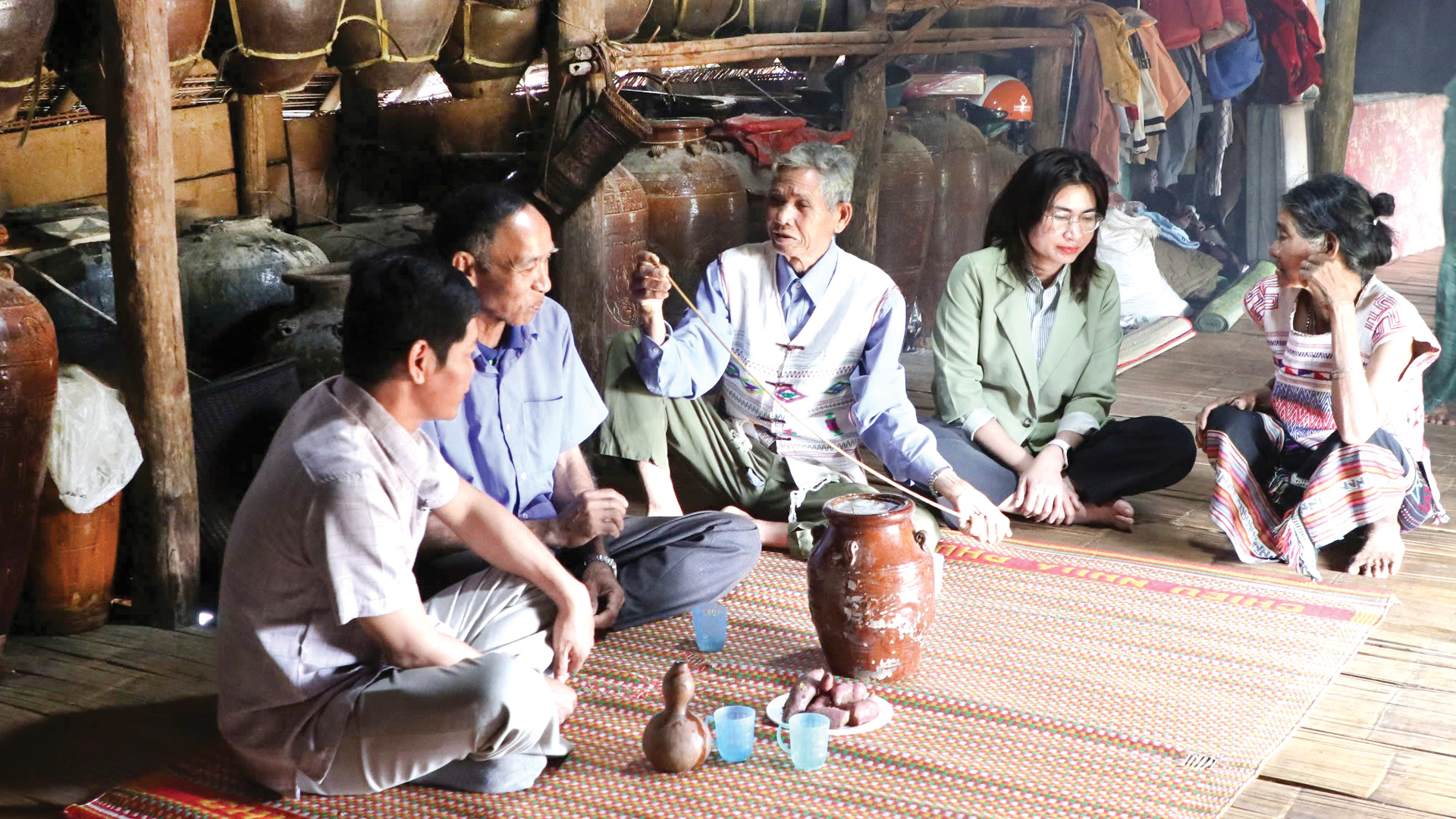 |
| Generations of Ma people in Loc Bac commune gather around the traditional long house |
• OLD ROUTINES EXTENDED
In the hot days of March, in the hot sun of the Southern Central Highlands, we were warmly welcomed by the people of Bo Dang village (Hamlet 2, Loc Bac commune) at a longhouse that is nearly a hundred years old. No one knows how long this house has existed, only hearing the elders in the village say that the Ma people's houses here have been passed down for three to four generations.
During the resistance war against the French and especially during the years of fighting against the Americans to save the country, the Ma people's residences were mainly revolutionary bases, and some places were even temporarily occupied areas. Their roofs were often long houses located under the rows of vông trees. Despite many social changes and cultural integration, the Ma people still retain their simple and gentle nature, especially when welcoming guests from afar. Mr. K'Nui - Secretary of the Party Committee of Loc Bac commune shared: "The long house is a valuable asset left by our ancestors, a place to raise jars and preserve the relics and culture of the Ma people from the past to the present".
More than ten years ago, I had the opportunity to visit the Ma people's long house. At that time, the long house had up to seven kitchens, meaning seven families lived under one roof. At night, in the cozy space of the long house, the sound of gongs echoed with the sacred fire, creating a mysterious space. However, as time changed, the long house became smaller and smaller, no longer built as spacious as before. Mrs. Ka Dit, the owner of the long house, said: "In the past, there was a lot of bamboo in the forest, so repairing was easy, but now the forest is sparse, there is less bamboo, and the cost of repair is very expensive. In the past, when someone wanted to build a long house, the villagers would support and help. But now, everyone is too busy with life, everyone wants to build a solid house for convenience. Who still remembers the long house of our ancestors? If they do, they are only stories in our memories that we pass on to each other by word of mouth."
In the memories of the elderly in Bo Dang village, the long house is a common living place for three or four generations. Mr. K'Xung, a prestigious person in Hamlet 2, said: "The long house is a unique architectural style, a familiar place of residence for people in mountainous and forest areas. In that space, there is no division or disunity, all families live in harmony." According to him, the way of living together in the long house is a natural reflection of social life when the Ma people cope with natural disasters, wild animals and wars, while at the same time deepening the sense of solidarity to protect the survival of each family member.
• WANT TO PRESERVE TRADITIONAL VALUES
In recent years, the Ma community in Loc Bac has only a few long houses left, each with only about 2-3 kitchens. The risk of losing the "long house culture" is obvious. Deputy Secretary of the Party Committee of Loc Bac commune, Ka Huong, shared humorously, but also with great sadness: "People now like to live in solid concrete houses. Modern life, the trend of compact families, with the independence of "one kitchen" has become popular in the Ma community. Only Mrs. Ka Dit, although her children and grandchildren have built a solid house, still wants to stay with the long house, to preserve and raise the jars and pots."
Although the changes of modern life have somewhat faded the image of traditional long houses, the values that the houses bring are still there in the hearts of the Ma people. The ancient gongs, jars, and pots, considered sacred protection objects of each family, are still priceless spiritual assets. The sounds of gongs, the lullabies of mothers, and the warm space of the long house have become indispensable parts of the cultural life of the Ma people.
Sharing about the efforts to preserve the long house culture of the Ma people, Ms. Ka Dit said: “Although time has passed, the customs and practices of our ancestors cannot be abandoned. We still want to preserve these traditional values, so that the next generation can understand the history and culture of our people.”
With these concerns, the Ma people in Loc Bac commune continue their journey to preserve and maintain the beauty of traditional culture. We only hope that, with the enthusiasm and consensus of the community, the long house - a symbol of solidarity and national identity - will not only be a memory, but will forever exist in the hearts of the Ma people and in the space of the Central Highlands.
Source: https://baolamdong.vn/van-hoa-nghe-thuat/202503/nha-dai-trong-tam-thuc-nguoi-ma-309460f/



![[Photo] Ho Chi Minh City: People are willing to stay up all night to watch the parade](https://vphoto.vietnam.vn/thumb/1200x675/vietnam/resource/IMAGE/2025/4/29/cf71fdfd4d814022ac35377a7f34dfd1)
![[Photo] Prime Minister Pham Minh Chinh meets to prepare for negotiations with the United States](https://vphoto.vietnam.vn/thumb/1200x675/vietnam/resource/IMAGE/2025/4/29/76e3106b9a114f37a2905bc41df55f48)
![[Photo] General Secretary attends special art program "Spring of Unification"](https://vphoto.vietnam.vn/thumb/1200x675/vietnam/resource/IMAGE/2025/4/29/e90c8902ae5c4958b79e26b20700a980)
![[Photo] Nghe An: Bustling atmosphere celebrating the 50th anniversary of Southern Liberation and National Reunification Day](https://vphoto.vietnam.vn/thumb/1200x675/vietnam/resource/IMAGE/2025/4/29/64f2981da7bb4b0eb1940aa64034e6a7)
![[Photo] Hanoi is brightly decorated to celebrate the 50th anniversary of National Reunification Day](https://vphoto.vietnam.vn/thumb/1200x675/vietnam/resource/IMAGE/2025/4/29/ad75eff9e4e14ac2af4e6636843a6b53)




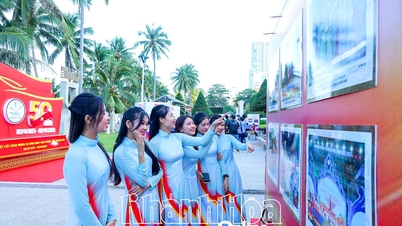









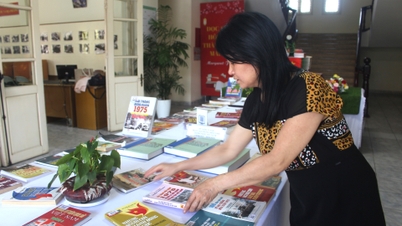
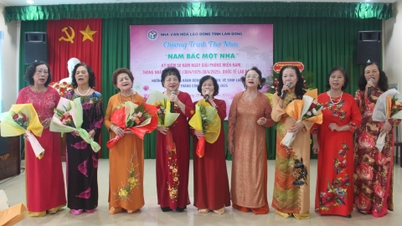
![[Photo] People choose places to watch the parade from noon on April 29](https://vphoto.vietnam.vn/thumb/1200x675/vietnam/resource/IMAGE/2025/4/29/3f7525d7a7154d839ff9154db2ecbb1b)













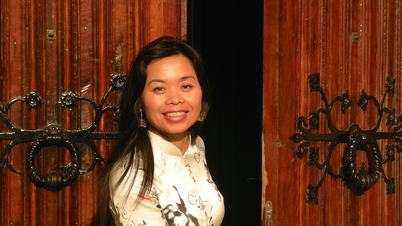



















































Comment (0)